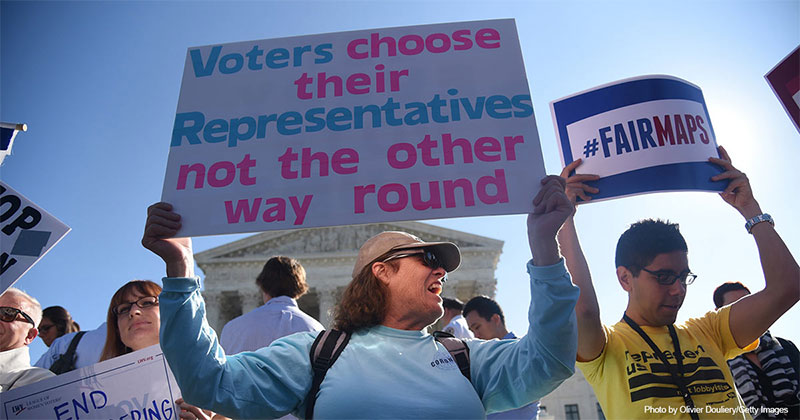
If there’s a breakthrough on the horizon of the government shutdown, you wouldn’t know it from House Minority Leader Hakeem Jeffries’s (D-N.Y.) whereabouts. The Democratic leader left D.C. — and its partisan messaging wars — for a Monday jaunt in Illinois, where he hoped to make a dent in another nationwide clash: redistricting. The jaunt, which underscored the urgency both parties feel to redraw their congressional maps, is the latest push in a see-saw battle to shake up the House’s slim majority.
As most people watched with interest this past August, the furious arms race between red states and blue states for House seats kicked off in Texas, where the Trump Justice Department gently reminded leaders that it was in violation of a recent court order on how congressional lines were drawn. When Lone Star State leaders moved to correct the problem, introducing legislation to rewrite district lines, Democrats revolted, leaving the state in dramatic style to try to grind the debate to a stop. Ultimately, their stunt failed, and GOP officials chased the lawmakers back home, where the proposal soon passed.
What most Americans didn’t know — and the media was careful to ignore — is that Texas was responding to a Fifth Circuit Court decision months earlier that upended a controversial provision in the Voting Rights Act. In the late 1980s, legislators amended the law to mandate certain majority-minority districts. The point was to ensure that black votes weren’t diluted in majority-white areas.
Now, six decades after the Act was passed (and four since this radical modification to the law), there’s widespread concern that the legislation has actually sparked the discrimination it was designed to prevent. After all, Politico explains, “The districts created as a result of the tweak to the law are almost entirely represented by Democrats, something that Republicans have long claimed gives the party an unfair advantage.”
As the National Review editors point out, “More than a dozen congressional districts as well as many state legislative districts are drawn along openly racial lines for the explicit purpose of separating voters into racial enclaves. We do not need racial gerrymandering to target a problem that recedes ever further into our past. Nothing in the Constitution,” they argue, “requires this. To the contrary, as the Court has warned for decades, using race as the predominant factor in drawing district lines violates the 14th and 15th Amendments’ guarantees of equal protection and freedom from race discrimination in voting rights.”
The Supreme Court has a chance to radically overhaul the Voting Rights Act this term, and states across both political spectrums are scrambling to reshape their congressional maps in the hopes of swaying what will be a furiously competitive midterm election.
In Texas, North Carolina, Missouri, and Utah, conservatives got off to a fast start, revising their districts to be more competitive for Republican candidates. Some estimates put the GOP pick-up at about seven seats in the U.S. House. But that was before New York, Illinois, Virginia, and California clapped back, moving aggressively to respond and, in Golden State Governor Gavin Newsom’s (D) case, bypassing the state constitution to do so.
As Time magazine Senior Correspondent Phillip Elliot explains, “California actually has one of the better — and consistent — non-partisan systems for creating fair political maps based on the results of the U.S. Census conducted at the top of each decade.” And yet with Proposition 50, slated to come before voters on November 4, the independent system for drawing the congressional lines would be replaced by the Democrat-controlled legislature, effectively rigging the process for decades to come.
But in Democratic circles, there’s a growing pushback to the idea. In places like Illinois, Jeffries met a surprising amount of resistance to his crusade to reimagine House races from black leaders, who fear that they’ll be drawn out of their seats in the party’s quest for more power. In bright bold lines, the caucus’s chair, state Senator Willie Preston (D),“issued a public warning to Jeffries that it won’t support a map that dilutes Black voting population in historically Black districts,” Punchbowl reported. To squeeze another Democratic seat out of the Land of Lincoln, Jeffries would have to elbow out a black lawmaker.
“It’s pretty incredible that state legislators can summon the House minority leader to Chicago to extract political promises in return for diluting racially-gerrymandered seats,” Family Research Council’s Quena Gonzalez emphasized, “and Washington pretty much yawns.” He added, “When intersectional race preferences collide with mathematical reality, I guess something’s gotta give.”
In Maryland, the internal tension over redistricting is roiling local politics. The Hill described a new line drawn in the sand by state Senate President Bill Ferguson (D), who distributed a Dear Colleague letter Tuesday killing the party’s redistricting dreams because the effects would be, in his words, “catastrophic.”
“Despite deeply shared frustrations about the state of our country, mid-cycle redistricting for Maryland presents a reality where the legal risks are too high, the timeline for action is dangerous, the downside risk to Democrats is catastrophic, and the certainty of our existing map would be undermined,” he wrote. Besides, like so many blue states, the reality is there isn’t much to be gained. Democrats have already eked out as many gerrymandered areas as possible. In Maryland, there are eight congressional seats, and just one is held by a Republican.
In Virginia, the headwinds are strong for a different reason. After Speaker of the House Don Scott (D) announced a special session to consider new district lines. “In my legal opinion,” Minority Leader Terry Kilgore (R) fired back, “the election has already started, and it’s too late constitutionally to have such a vote. So we are going to use everything, legally, everything that we can do, to stop this power grab.”
Kilgore’s analysis was backed up by the state’s Republican attorney general, Jason Miyares, who issued a four-page opinion on Tuesday dashing the Democrats’ hopes of changing anything soon. “Under Virginia law, the entire membership of Virginia House of Delegates is elected every two years, in odd-numbered years, for terms beginning in the following even-numbered year,” the opinion read in part, “In accordance with law, Virginia voters are currently casting their ballots for the candidates they prefer to represent them as delegates for the term that begins in 2026 — and have been doing so for weeks.”
Regardless of the flurry of activity in the states, no one will shape America’s elections as much as the Supreme Court. If the justices strike down Section 2 of the Voting Rights Act that demanded majority-minority districts, then a lot of the Democrats’ scheming will be moot. Even now, The New York Times concedes, “Despite all the gerrymandering by both political parties in recent years, neither has been able to obtain a significant structural advantage in the House so far this decade. In two very close elections, the party that won the most votes won the most seats. That’s partly because each side’s gerrymanders canceled the other’s out.” But, the Times stresses, “if Section 2 falls, and Republicans redraw districts across the South, Democrats will be at enough of a structural disadvantage that even with a five-point victory, their chances might depend on upsets in a few heavily Republican districts.”
FRC Action Director Matt Carpenter agreed. “While it looks as though we’re still early in the mid-decade redistricting fight,” he told The Washington Stand, “it is clear the GOP has the simplest path to gaining more districts. Democrat-led states typically have to devise some clever workaround for their independent redistricting commission, which, in most cases, has already just about maxed out the gerrymandering potential in their state. Republican states typically do not have these restrictions, have more room to maximize the impact of Republican voters in their states, and with the potential of the Supreme Court overturning portions of the Voting Rights Act, could free up as many as 19 additional seats for red states to go after.”
Sure, he admitted, “Blue states will do their best to cancel out as many of these new seats as possible, but it’s hard to see how they can possibly come out on top at the end, with their voters so centralized in so few locations and the hurdles they have to clear before they can even look at redrawing maps in their states.”
That said, this is definitely a battle for the ages. “It’s happened two other times in American history,” Carpenter underscored. “Normally, when you get this mid-decade redistricting, it’s because of a court order, [a law changes] … or there’s a legal challenge to an existing map, and suddenly the state legislature is coming in for a special session to redraw districts. This is the third time in American history where you’ve got a voluntary mid-decade redistricting that’s happening before a census. ... So we are in sort of an unprecedented time in American history right now.”
















